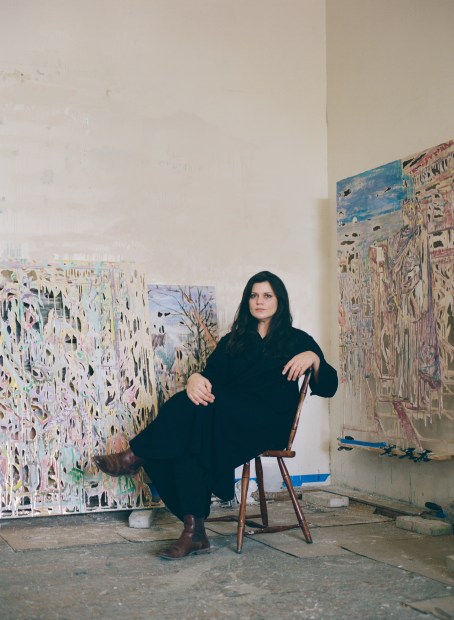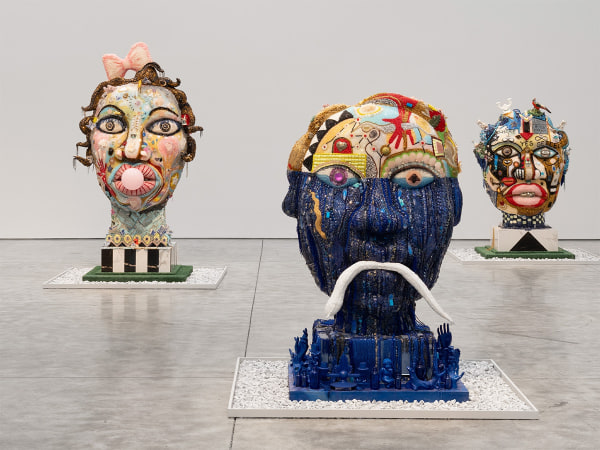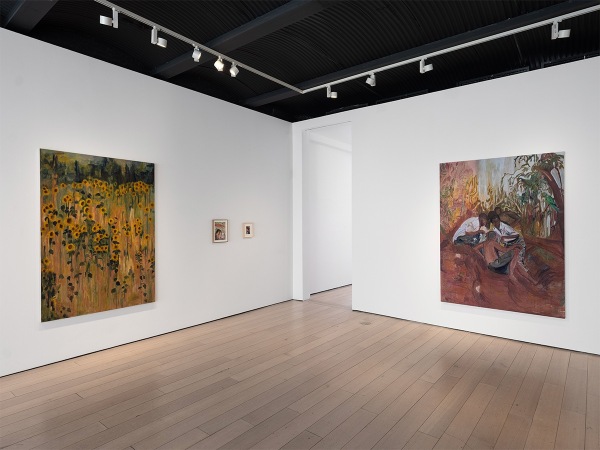Diana Al-Hadid: Women, Bronze, and Dangerous Things
-
-
Diana Al-Hadid’s first solo exhibition with the gallery, Women, Bronze, and Dangerous Things, spans both 509 West 27th Street and the Kasmin Sculpture Garden from November 2–December 22, 2023. Featuring an extensive new body of work developed over the last five years, the exhibition underscores the artist’s singular approach to relief and large-scale sculpture alongside a new series of mixed media drawings on Mylar, as well as works on paper pulp developed as part of her residency at Dieu Donné, New York. Known for her evocative transformations of industrial materials such as fiberglass, gypsum, steel, and bronze, Al-Hadid’s works engage with thematic references across the fields of antiquity, folklore, architecture, manuscripts, cartography, and cosmology, among other subjects, as a way of communing with the present.
Across Al-Hadid’s use of motifs in this exhibition—which includes figures from Greek mythology alongside protagonists in Islamic and Christian narratives—the artist’s contemporary interpretations intuitively navigate different attempts of reading the future through our past. Constructions in nature such as mountains and caves reappear as emblematic elements of landscape tied to the social, psychological, and religious narratives that have been absorbed into dominant culture over the centuries. Indifferent to where these narratives find their origin in theology, Al-Hadid’s method of retrieving stories both communicate with history and imagine them anew. At once prophetic and autobiographical, Al-Hadid’s sensitive installation across two sites of the gallery’s architecture articulates a realm that manifests, both physically and metaphorically, above ground and below.
The exhibition title borrows its structure from a book by American linguist and philosopher George Lakoff, Women, Fire, and Dangerous Things: What Categories Reveal About the Mind, published in 1987. Citing the importance of categorization to human cognition, a necessary impulse in the development of the psyche and the evolution of our species, Al-Hadid considers the complex facets of identity and understanding intrinsic to the immigrant experience. How does one categorize ‘home’ when they no longer occupy the land in which they were born? Do the origin stories of that site belong to one that identifies with, and without, a nation? Across Al-Hadid’s works present in this installation, we return to the question of how selves that exist on the threshold of classification interact with history. -
-

-
In Mother Splits the Moon (2023), the artist’s first suspended sculpture, the phantasmic outline of a reclining female figure manifests from a linear composition bathed in hues of bronze and oxidized blue. Reaching the entire height of the gallery ceiling, her torso arises from a sedimentary platform that appears to trace layers of glacial material, as if the hovering base of the sculpture was carved from a cross section of frozen ground. The characteristic pose of this enmeshed body finds a formal echo in the two major works installed upon the roof of the Kasmin Sculpture Garden above, In Mortal Repose (2011), the artist’s first figurative bronze, and Double Standard (2022), which presents an inversion—the stacked figures are adjoined at the neck to create a nearly symmetrical composition of headless bodies, the top dissolving into the other similar to how sand passes through an hourglass.
This selective featureless approach to representation is carried in Al-Hadid’s treatment of recurring portrayals of the Ancient Greek mythological figures Danae and Medusa, women that each hold a critical space of reverence and power in the artist’s recent work. Across two-dimensional reliefs such as The Bronze Chamber of Danae (2023) or Blue Medusa (2023) and related works on paper, their implied presence is traced through the depiction of subjects that surround them. In the case of Danae, Al-Hadid’s meticulous compositions of metallic marks reference the transformation of Zeus into golden coins that shower upon her, whereas Medusa is depicted in a suite of wall-mounted reliefs and works on paper via the serpents that encircle her. While neither is given explicit form, the non-human elements that accompany both women through centuries of historical European painting and sculpture, to signify either the signals or consequences of rape, are abstracted in Al-Hadid’s mesmerizing compositions.
-

-
-
Unfastened from linear time, Al-Hadid’s engagement with her source material provokes an experience of ‘anemoia,’ a term invented by writer John Koenig to define a feeling of nostalgia for a past you have never known. Alongside ancient mythology, several of Al-Hadid’s works reference the compositions of 16th-century Falnama, or book of omens. Quoting the compositions of these divine manuscripts, often used for the purposes of ritualistic fortune-telling, the artist’s works on paper made at Dieu Donné—the leading nonprofit cultural institution dedicated to the use of hand papermaking processes in contemporary art founded in 1976—emulate the same frontal experience of Persian Miniatures. Likewise, Al-Hadid’s opalescent wall relief The Seven Sleepers and the Dog (2023) cites Islamic depictions that chronicle the story of Christian men who escaped persecution by miraculously sleeping in a cave for 309 years—ideas and motifs that can be traced back to the artist’s Smithsonian Artist Research Fellowship in 2021.
In what can be seen as a key to the exhibition, Warda (2023) exists as a bronze of a rootbound jasmine plant. Cast from remnants of the artist’s work The Time Being, commissioned as part of the 2022 FRONT Triennial in Cleveland, the entangled roots can be read as a kind of allegory of how Lakoff’s categories falter when faced with the irregularities between cultures and minds. The title of the work shares its name with the singer Warda Al-Jazairia, the renowned diva of Arab song whose music partly inspired the piece, as well as the Arabic word related to flower. Returning to Lakoff’s Women, Fire, and Dangerous Things, the author proposes that countries, our conception of nations, share a category with the male gender. “I was listening to a love song of Warda’s, written to a man, and I could not help but hear the longing in her voice addressing a native country,” says Al-Hadid.Jasmine is the national flower of Syria, but here it is also an autobiographical emblem of the artist’s practice. Making visible what is often underfoot, the work stands as a relic of the immigrant experience—of the need to grow in a new territory, of the unconscious binds that surround us, of coming home.
The exhibition runs concurrently with Al-Hadid’s major site-specific project for the upcoming NGV Triennial at The National Gallery of Art, Australia, which opens on December 3.
-

-

-

-

-
-
-

-

-
-
-

-

-
-

-
“I’m interested in breaking the perception of bronze sculpture in public art, that heroic quality. Monuments are of interest to me, but in a weirdly intimate way. My hand is in every part of it. I’m expecting that when you see the bronzes, they’ll feel more tender than monumental.” —Diana Al-Hadid
-

-
About the Artist
 Portrait by Charlie Rubin.
Portrait by Charlie Rubin. -
Join our Newsletter
* denotes required fields
We will process the personal data you have supplied in accordance with our privacy policy (available on request). You can unsubscribe or change your preferences at any time by clicking the link in our emails.
-
Explore
-

vanessa german: GUMBALL—there is absolutely no space between body and soul
April 3 – May 10, 2025 509 West 27th Street, New York, 514 West 28th Street, New YorkKasmin presents its second solo exhibition of new work by artist vanessa german (b. 1976), which debuts related bodies of sculpture across two of the gallery’s spaces in New York. GUMBALL—there is absolutely no space between body and soul deepens german’s singular approach to sculpture as a spiritual practice with the power to transform lived experience. Both series comprise mineral crystals, beads, porcelain, wood, paint and the energy that these objects bring to life to form monumental heads and figures in the act of falling. Together, each body of work envisions the transformation of consciousness necessary to imagine a new world. -

Helena Foster: Time Honoured
April 3 – May 3, 2025 297 Tenth Avenue, New YorkThe first New York solo exhibition of London-based painter Helena Foster features new oil paintings on linen, paper, and vellum that express the artist’s lyrical approach to painting as an accumulation of cultural and generational wisdom. Foster draws freely from literature, theater, film, Igbo oral tradition, and religion, achieving a dreamlike aura of mystery in dynamic compositions ambiguously set between thick vegetation and the built environment.
-

























